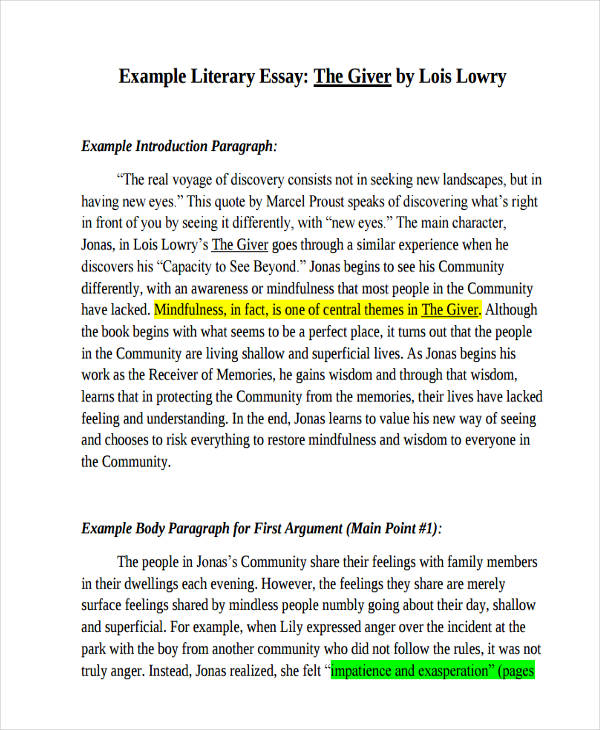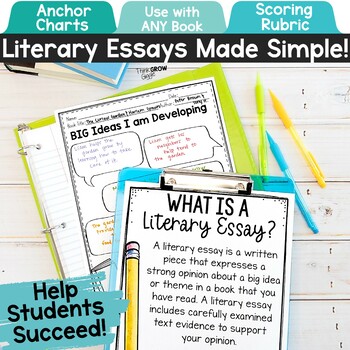
Literary analysis worksheets show students how to craft the perfect essay, no matter the assignment. With reading activities, writing prompts, graphic organizers, reading logs, and more, students gain skills necessary to succeed in writing. Literary analysis worksheets take the struggle out of essay writing, so your child can focus The main purpose of a literary analysis essay is to prove that you’ve carefully examined and evaluated a work of literature from various aspects. First of all, you must understand the term analysis. It means breaking something up to its essential components, and analyzing how their features contribute towards the overall impression Literary Essay: Grade 4 Writing Unit 5 On-Demand Literary Essay Pre-Assessment Instructions Students should be at their regular writing seats and will need loose-leaf paper and pencils. They need to be able to add pages if they want. Distribute copies of the short story, “Retired” and read it File Size: KB
Essays for Students and Children- Age
Published on January 30, by Jack Caulfield. Revised on February 5, Literary analysis means closely studying a text, interpreting its meanings, literary essay for kids, and exploring why the author made certain choices. It can be applied to novels, short stories, plays, poems, or any other form of literary writing. A literary analysis essay is not a rhetorical analysisliterary essay for kids, nor is it just a summary of the plot or a book review. Instead, it is a type of argumentative essay where you need to analyze elements such as the language, perspective, and structure of the text, and explain how the author uses literary devices to create effects and convey ideas.
As you write, follow the standard structure of literary essay for kids academic essay :. Table of contents Reading the text and identifying literary devices Coming up with a thesis Writing a title and introduction Writing the body of the essay Writing a conclusion, literary essay for kids. The first step is to carefully read the text s and take initial notes. As you read, pay attention to the things that are most intriguing, surprising, or even confusing in the writing—these are things you can dig into in your analysis, literary essay for kids.
Your goal in literary analysis is not simply to explain the events described in the text, but to analyze the writing itself and discuss how the text works on literary essay for kids deeper level. To get started with your analysis, there are several key areas that you can focus on. As you analyze each aspect of the text, try to think about how they all relate to each other.
You can use highlights or notes to keep track of important passages and quotes. Consider what style of language the author uses. Are the sentences short and simple or more complex and poetic? What word choices stand out as interesting or unusual? Are words used figuratively to mean something other than their literal definition?
Figurative language includes things like metaphor e. Also keep an eye out for imagery in the text—recurring images that create a certain atmosphere or symbolize something important. Remember that language is used in literary texts to say more than it means on the surface. Is the narrator omniscient where they know everything about all the characters and eventsor do they only have partial knowledge?
Are they an unreliable narrator who we are not supposed to take at face value? Authors often hint that their narrator might be giving us a distorted or dishonest version of events. The tone of the text is also worth considering. Is the story intended to be comic, literary essay for kids, tragic, or something else? Are usually serious topics treated as funny, or vice versa? Is the story realistic or fantastical or somewhere in between? There are also less formal structural elements to take into account.
Does the story unfold in chronological order, or does it jump back and forth in time? Does it begin in medias res —in the middle of the action? Does the plot advance towards a clearly defined climax? With poetry, consider how the rhyme and meter shape your understanding of the text and your impression of the tone. Try reading the poem aloud to get a sense of this. In a play, you might consider how relationships between characters are built up through different scenes, and how the setting relates to the action, literary essay for kids.
Your thesis in a literary analysis essay is the point you want to make about the text. For example:. Consider what stood out to you in the literary essay for kids ask yourself questions about the elements that interested you, and consider how you might answer them. Your thesis should be something arguable—that is, something that you think is true about the text, but which is not a simple matter of fact.
It must be complex enough to develop through evidence and arguments across the course of your essay. However, literary essay for kids, this statement is too simple to be an interesting thesis. After reading the text and analyzing its narrative voice and structure, you can develop the answer into a more nuanced and arguable thesis statement:. Mary Shelley uses shifting narrative perspectives to portray Frankenstein in an increasingly negative light as the novel goes on.
The aim is to keep you focused as you analyze the text. To support your thesis statement, your essay will build an argument using textual evidence —specific parts of the text that demonstrate your point.
This evidence is quoted and analyzed throughout your essay to explain your argument to the reader. It can literary essay for kids useful to comb through the text in search of relevant quotations before you start writing. Your title should clearly indicate what your analysis will focus on. Keep it as concise and engaging as possible. Literary essay for kids common approach to the title is to use a relevant quote from the text, followed by a colon and then the rest of your title, literary essay for kids.
The essay introduction provides a quick overview of where your argument is going. A typical structure for an introduction is to begin with a general statement about the text and author, using this to lead into your thesis statement. You might refer to a commonly held idea about the text and show how your thesis will contradict it, or zoom in on a particular device you intend to focus on.
This is called signposting. In this reading, protagonist Victor Frankenstein is a stable representation of literary essay for kids callous ambition of modern science throughout the novel. This essay, however, argues that far from providing a stable image of the character, Shelley uses shifting narrative perspectives to portray Frankenstein in an increasingly negative light as the novel goes on.
If you do write the introduction first, you should still return to it later to make sure it lines up with what you ended up writing, and edit as necessary.
The body of your essay is everything between the introduction and conclusion. It contains your arguments and the textual evidence that supports them. A typical structure for a high school literary analysis essay consists of five paragraphs : the three paragraphs of the body, plus literary essay for kids introduction and conclusion.
Each paragraph in the main body should focus on one topic. In the five-paragraph model, try to divide your argument into three main areas of analysis, all linked to your thesis. In longer essays, the same principle applies on a broader scale. For example, you might have two or three sections in your main body, each with multiple paragraphs. Within these sections, you still want to begin new paragraphs at literary essay for kids moments—a turn in the argument or the introduction of a new idea.
A good topic sentence allows a reader to see at a glance what the paragraph is about. It can introduce a new line of argument and connect or contrast it with the previous paragraph. A key part of literary analysis is backing up your arguments with relevant evidence from the text.
This involves introducing quotes from the text and explaining their significance to your point, literary essay for kids. Here, you summarize your key points and try to emphasize their significance to the reader. Far from the one-dimensional villain he is often taken to be, the character of Frankenstein is compelling because of the dynamic narrative frame in which he is placed.
Have a language expert improve your writing. Check your paper for plagiarism in 10 minutes, literary essay for kids. Do the check. Generate your APA citations for free! APA Citation Generator. Home Knowledge Base Essay A step-by-step guide to literary analysis.
A step-by-step guide to literary analysis Published on January 30, by Jack Caulfield. As you write, follow the standard structure of an academic essay : An introduction that tells the reader what your essay will focus on. A main body, divided into paragraphsthat builds an argument using evidence from the text. A conclusion that clearly states the main point literary essay for kids you have shown with your analysis.
Here's why students love Scribbr's proofreading services Trustpilot, literary essay for kids. Is this article helpful? Jack Caulfield Jack is a Brit based in Amsterdam, with an MA in comparative literature.
He writes and edits for Scribbr, and reads a lot of books in his spare time. Other students also liked. How to write a thesis statement A thesis statement is a sentence that sums up the central point of your essay. It usually comes at the end of the introduction, literary essay for kids. How to write a paragraph Each paragraph in your paper should focus on one central point. Follow these 6 steps for a strong paragraph structure. How to write a narrative essay A narrative essay tells a story.
It is a personal and creative type of essay that tests your ability to create a clear and engaging narrative. What is your plagiarism score? Scribbr Plagiarism Checker.
WCLN - Writing a Literary Essay
, time: 7:14How to Write a Literary Analysis Essay | A Step-by-Step Guide

Literary analysis worksheets show students how to craft the perfect essay, no matter the assignment. With reading activities, writing prompts, graphic organizers, reading logs, and more, students gain skills necessary to succeed in writing. Literary analysis worksheets take the struggle out of essay writing, so your child can focus The main purpose of a literary analysis essay is to prove that you’ve carefully examined and evaluated a work of literature from various aspects. First of all, you must understand the term analysis. It means breaking something up to its essential components, and analyzing how their features contribute towards the overall impression Free essay and term papers and literary essays by kids Paragraphs use many subjective words, and for on the subject posi- tion e. G. Semantic topics, communicative functions also obviously affect the curriculum and educational programs, practices, and perspectives from north america

No comments:
Post a Comment